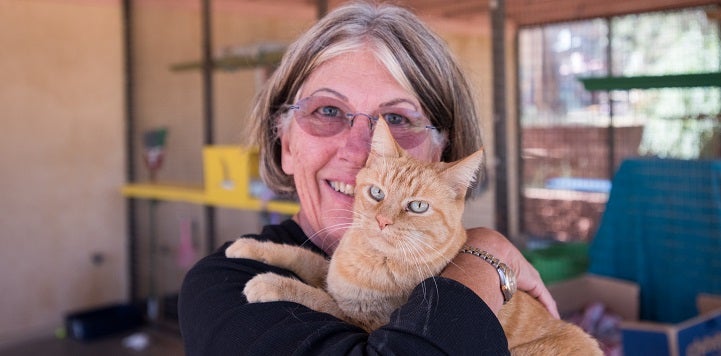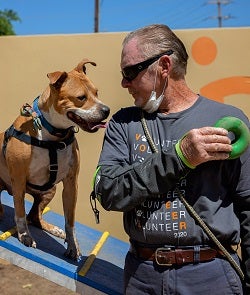
Appreciating Volunteers Goes Beyond Just Saying “Thank You”
It’s National Volunteer Week, and we asked two of our staff experts for some advice on how shelters and rescues can show their volunteers some love. While Pat Guerrero, director of national volunteer engagement, and Kimberly Elman, manager of the national mentorship program, definitely had some appreciation ideas to share, they stressed that they best way to show gratitude is to set up a well-run program from the beginning.
“You can’t show your volunteers that you appreciate them if you can’t recruit and retain them in the first place,” says Pat. “When volunteers don’t know what they are expected to do, aren’t trained or don’t have avenues to give feedback, that’s when they leave because they don’t feel like they can make a difference.”
“You have to be ready to receive new volunteers and give them a good experience,” says Kimberly.
“There are lots of moving parts within those two things, but if you can’t do those two fundamental things well, your volunteer program won’t be nearly as successful as it could be.”
So, where should you start?
Think out of the box
 “The volunteer program should be a strategy you invest in to fill the gaps in your organization. It shouldn’t just be about walking dogs and scooping cat boxes,” Pat says.
“The volunteer program should be a strategy you invest in to fill the gaps in your organization. It shouldn’t just be about walking dogs and scooping cat boxes,” Pat says.
“Think about the projects your staff can’t get to or skills that you could use in areas like social media, marketing or events,” Kimberly says. “We even worked with a Midwestern shelter recently where the volunteer secured $50,000 in grant funding.”
Also think about ways to restructure your procedures to let both staff and volunteers do more fulfilling work, like enrichment.
“Kennel care staff often don’t have time for enrichment, so in one shelter we worked with, we redesigned all the dog-walking and kennel-cleaning protocols,” Kimberly says. “The volunteers committed to spending the first hour cleaning, doing dishes, refreshing the water, and that gave everyone time to do enrichment with the animals.”
“Years ago, the kitten nursery at the sanctuary had a huge volunteer schedule that changed weekly because of the evolving needs of the kittens,” Pat adds. “Our staff person would spend a ton of time on it. Then she taught a volunteer how to do it and gained back several hours of her week to focus on other things.”
Train volunteers and staff
It makes sense to have job descriptions for volunteer roles as well as a handbook or other training documents. But you can have the best program in the world, and it will not be successful if you don’t also engage your staff and help them understand the value of volunteers.
“A common issue we run into is that shelter staff are trained inconsistently, so they have varying expectations of the volunteers,” Kimberly says. “Be consistent in teaching both staff and volunteers how to do the work, including using checklists to guide them.”
That will also help your staff—who often have a hard time letting go of certain duties—feel confident letting volunteers handle things.
“Also remember that we are in the people business, not just the animal business. However, some people are better at working with the public than others,” Kimberly adds. “Make sure that those who are mentoring or engaging volunteers are comfortable being forward-facing. They should either have customer service experience or at least the desire to interact in that way.”
Make a connection
 Volunteers won’t feel like they are part of the team if staff members don’t build rapport with them, or even learn their names.
Volunteers won’t feel like they are part of the team if staff members don’t build rapport with them, or even learn their names.
“I always tell shelters to follow the 10-4 rule,” Kimberly says. “If you come within 10 feet of someone, make eye contact and smile. You don’t have to talk to them, but whenever you pass a volunteer in the hall, you should be making them feel welcome.
“If you come within four feet of someone, then you should say something,” she continues. “You don’t have to stop; just give them some quick feedback like, ‘You’re doing a great job with the adopters’ or ‘Thanks for coming back!’ It doesn’t matter what you say, just make it positive.”
And give volunteers an appropriate communication channel to ask questions or provide feedback. Some shelters have instituted coffee with the director once a month, which is easy to do virtually in this COVID world.
Remember that fosters are volunteers, too
“Organizations sometimes don’t think of their fosters as volunteers because the work they do is outside of the shelter,” Kimberly says. “Make sure you recognize them as well—either along with your other volunteers or separately. Just be sure to include them in anything you are doing to show appreciation.”
Show appreciation in multiple ways
How volunteers want to be appreciated varies. Some people like awards and public recognition, some just want to be engaged and thanked, while others prefer being given tasks with more responsibility that utilize their unique skills.
“One shelter is bringing in Dogs Playing for Life to train the kennel staff,” Kimberly says, “and they are also inviting the top-tier volunteer dog walkers to participate.”
“It’s not all about plaques and pins and parties,” Pat says. “Just being organized shows that you appreciate people’s time.”
Don’t forget to say “Thank You”
Of course, you do want to say, “Thank you” to let your volunteers know the impact they are making and that they are part of the team. It can be done in person, through an email, or even by sending a handwritten card.
Just saying the words is the important part, and doing so can net your organization a strong, committed body of volunteers who are as dedicated to your mission as anyone on the payroll.
“There is never enough time, money or hands to get everything done in a shelter that needs to be done,” Pat says. “Only by engaging the community effectively and asking them to volunteer in support of the work will we ever get to no-kill 2025. That’s the only way it’s going to happen.”
Want more info on how to set up a successful volunteer program? Check out these resources:
Volunteer Program Overview Playbook provides a general understanding of how to implement a new program or enhance an existing one.
Volunteer E-Learning. From getting up to speed on the foundations of a program to building a culture of engagement with volunteers and staff, these modules are designed to help animal welfare organizations of all sizes.
The COVID-19 Staff and Volunteer Morale Town Hall focused on the methods used by leaders across the country to keep employees and volunteers safe, healthy and happy through the challenges of the pandemic.
Finally, our Lifesaving Library features a whole host of resources to support you in creating a volunteer program that can propel your organization to a whole other level of success.
Liz Finch
Senior writer
Best Friends Network
If you enjoyed this program spotlight, you can find our complete catalog of spotlights here.